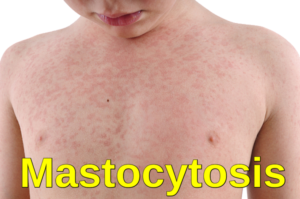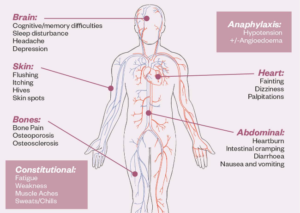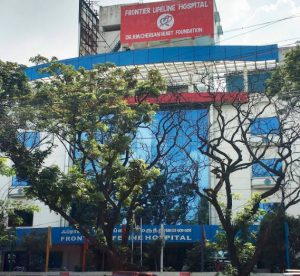Systemic Mastocytosis
What is Systemic Mastocytosis? Systemic mastocytosis, also known as clonal mast cell disease, is a disorder that produces a vast number of mast cells present in the white blood cells that accumulate and build up in the body. Many mast cells accumulate in the skin, digestive tract, bone marrow, or other essential organs. The white […] Read More
Top Doctors For Systemic Mastocytosis Treatments
Top Hospitals For Systemic Mastocytosis Treatments
Systemic Mastocytosis
What is Systemic Mastocytosis?
Systemic mastocytosis, also known as clonal mast cell disease, is a disorder that produces a vast number of mast cells present in the white blood cells that accumulate and build up in the body. Many mast cells accumulate in the skin, digestive tract, bone marrow, or other essential organs. The white blood cells are present in the tissues and are connected to the whole body. They boost immune effectiveness and enhance performance in the protection from diseases. They are also responsible for the quick healing of wounds and repairing tissues. Substances like spicy food, medications, stings, or even alcohol can trigger mast cells, causing symptoms similar to that of an allergy or inflammation that could be detrimental as it might result in the damage of some organs. These triggers can disperse histamine chemicals that lead to itching alongside flushing the neck, chest, and face. Severe cases of systemic mastocytosis are dangerous as it affects the working capabilities of some organs. Sometimes, the white blood cells might prompt a reaction known as anaphylaxis, which tends to be life-threatening, and medical aid is required immediately. Picture Courtesy: ask hematologist
Picture Courtesy: ask hematologist
What are the Types of Systemic Mastocytosis?
Two types of mastocytosis vary based on the occurrence and age group. Picture Courtesy: Osmosis
Picture Courtesy: Osmosis
-
-
- Cutaneous
-
-
-
- Systemic
-
i. Mast Cell Leukemia
This form of systemic mastocytosis is an aggressive form as it is characterized by the disease in which the accumulation of the mast cells occurs in the bone marrow and the blood.ii. Mast Cell Sarcoma
The mast cell sarcoma evolves due to the presence of a tumor due to the build-up of the mast cell. This tumor can form anywhere in the body apart from the skin. As stated previously, systemic mastocytosis occurs mostly in adults aged 40 to 60 years. The presence of systemic mastocytosis causes some triggers that can disperse chemicals in the body, leading to inflammation and other symptoms. Also, having symptoms without triggers is possible.What are the most common factors that can trigger the symptoms of systemic mastocytosis?
The triggers are not the same for all patients, but the common triggers that could lead to symptoms are:-
-
- Spicy food intake.
- Intake of alcohol.
- Stress.
- Vaccines.
- Anxiety.
- Stings from insects.
- Surgery.
- Temperature change.
- Nonsteroidal anti-inflammatory drugs (NSAIDs).
- Friction on the skin.
- Exercising.
-
What are the most common complications associated with Systemic Mastocytosis?
Complications associated with systemic mastocytosis are briefly explained below:-
-
- Blood Disorders
-
-
-
- Organ Failure
-
-
-
- Anaphylactic Reaction
-
-
-
- Reduction in Bone Density
-
-
-
- Peptic Ulcer Disease
-
How is Systemic Mastocytosis Diagnosed?
Processes used for the diagnosis of systemic mastocytosis are explained below:-
-
- Bone Marrow Biopsy
-
-
-
- Skin Biopsy
-
-
-
- Blood and Urine Tests
-
-
-
- Imaging Test
-
-
-
- Genetic Test
-
-
-
- Endoscopy or Colonoscopy
-
How is Systemic Mastocytosis treated?
The treatment option for systemic mastocytosis is primarily for symptoms. There is no cure for this disorder. Treatment modalities include medications such as-
-
- Epinephrine
-
-
-
- Antihistamine
-
-
-
- Mast Cell Stabilizers
-
-
-
- Proton Pump Inhibitors
-
-
-
- Targeted Therapy
-
-
-
- Steroids
-
-
-
- Chemotherapy
-
-
-
- Stem Cell Transplant or Bone Marrow
-
Symptoms
What are the most common symptoms associated with systemic mastocytosis?

Picture Courtesy: health awareness
The symptoms of systemic mastocytosis depend on the severity and extra abnormal mast cell present in the body. These symptoms are:
-
-
- Blisters on the skin are mainly for children.
- Nasal congestion.
- Reduction in blood pressure.
- Vomiting.
- Nausea.
- Blotches on skin.
- Flushing.
- Pain in the bone.
- Irregularities in a heartbeat.
- Anemia.
- Headache.
- Fatigue.
- Osteoporosis
- Increase in size of the spleen, lymph nodes, or liver.
-
Causes
What are the most common causes of systemic mastocytosis?
Due to the origin of systemic mastocytosis, the disorder has been considered hereditary, but this conclusion is wrong. Systemic mastocytosis is not a hereditary condition.
Systemic mastocytosis is caused by a haphazard alteration or mutation of the KIT gene in the body. This alteration tends to occur mainly after conception. The KIT gene is responsible for the growth of the cells in the body attributed to the regulation of the protein in this cell. Therefore, they are partially responsible for the way the mast cells grow.
Overview of Systemic Mastocytosis

Picture Courtesy: Pininterest
FAQ
How common is systemic mastocytosis?
Mastocytosis is a rare disorder as it affects one in every 20,000 people.
Who does mastocytosis affect?
Mastocytosis affects every age group, but systemic mastocytosis occurs only in adults, while the cutaneous affects only children. It is not gender-selective as it affects both genders equally.
How can you prevent systemic mastocytosis?
Systemic mastocytosis is a genetic disorder. Therefore, there is no prevention, but if the patient is diagnosed with the disorder, one can prevent an outbreak by consulting a doctor to prescribe prescriptions that could curb triggering to make it severe.
Is systemic mastocytosis hereditary?
The disorder is associated with the gene but is not hereditary. It results from mutation or change in a specific gene known as the KIT gene.
Between the systemic mastocytosis and the cutaneous mastocytosis, which is more severe?
Systemic mastocytosis is a more life-threatening situation as people diagnosed with aggressive systemic mastocytosis survive just for a few years or a little longer with antihistamines and drugs that could prevent triggers.
Can systemic mastocytosis turn into leukemia?
Systemic mastocytosis can turn into cancer (leukemia). The risk of systemic mastocytosis becoming cancerous is 7% when the disease begins in childhood and around 30% in adults.
Is systemic mastocytosis an autoimmune disease?
Yes, systemic mastocytosis is an autoimmune disorder in which the mast cells grow abnormally and can cause a wide range of symptoms.
Is systemic mastocytosis associated with hematologic neoplasm?
Yes, systemic mastocytosis is associated with hematologic neoplasm.










































